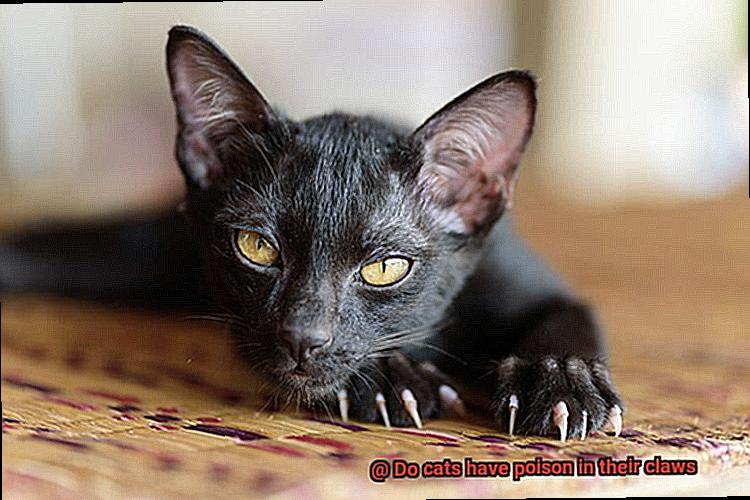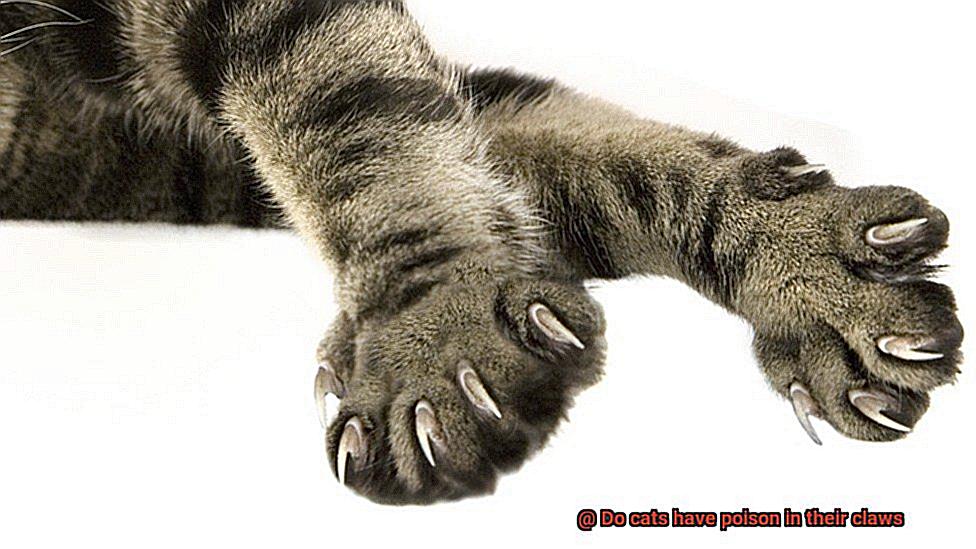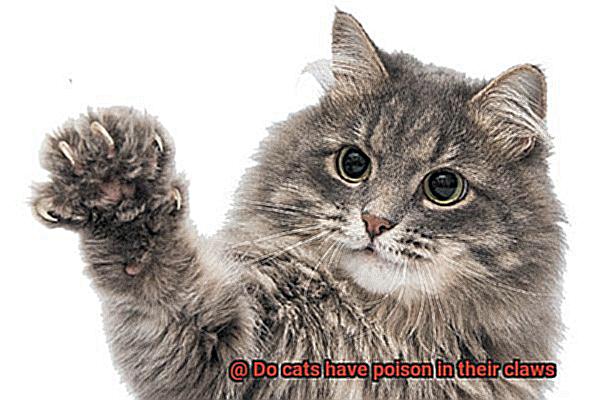Have you ever watched your cat’s claws retract and wondered if they were laced with venom? Or have you found yourself nursing a scratch from your feline friend, wondering if it could be more than just a painful wound? Fear not, dear reader, for we are here to answer the question: do cats have poison in their claws?
Cats are known for their sharp claws, which they use for everything from climbing to scratching. However, some people believe that these retractable weapons can also be deadly poisons used to incapacitate prey or defend against predators.
But let’s get one thing straight: cats do not have poison in their claws. While they may look intimidating, their claws are simply evolved to be incredibly sharp and efficient natural weapons.
In this post, we’ll delve into the structure and function of cat claws, debunk the myth of venomous claws, and explore the science behind the real danger of cat scratches. So stick around and get ready to learn more about your feline friends’ natural defenses.

What Is the Myth About Cats Having Poison in Their Claws?
Cats have been the subject of many myths and legends throughout history, and one of the most popular ones is the belief that they have poison in their claws. However, this idea is entirely false.
Domestic cats do not have venomous claws. Their sharp claws are made up of keratin, just like human nails. The myth probably originated from observing wild cats such as lions and tigers, which use their retractable claws to inject venom into their prey. However, domestic cats do not have this ability.

While cats may not have poison in their claws, they are still skilled predators that use their sharp claws and teeth for hunting and self-defense. Cats are experts at climbing and can quickly escape danger by climbing up high trees or structures. They also have the ability to retract their claws, keeping them sharp and ready for use when needed.
It is important to note that while cat scratches may not be poisonous, they can still be harmful. Cats can carry bacteria on their claws that can cause infections if they scratch a person or another animal. To avoid infections, it is essential to clean and disinfect any scratches thoroughly.
To prevent damage to furniture, clothing, and human skin caused by excessive or aggressive scratching behavior, it is vital to train cats to use scratching posts and trim their claws regularly.

Do Domestic Cats Have Poison in Their Claws?
Firstly, let’s dispel the myth that domestic cats have venomous claws. This is entirely false. While cats are skilled predators that use their sharp claws for hunting and self-defense, they do not have poisonous claws like some wild cats such as the African leopard or North American bobcat.
These wild cats have retractable claws equipped with sharp, curved hooks called “retrorsely-oriented sheaths.” These sheaths can contain toxins that are released when the cats scratch their prey, causing paralysis or even death in smaller animals. However, domestic cats do not possess these sheaths and therefore cannot release any toxins.
While domestic cats’ claws may not be poisonous, they are still sharp and can cause injuries to their prey or even their owners. When a cat scratches, it may leave behind bacteria that can lead to infections in humans. This is why it’s essential to clean and disinfect any scratches thoroughly.
It’s also important to note that domestic cats may still carry harmful bacteria on their paws and claws. That’s why it’s recommended to regularly trim your cat’s nails and wash your hands after handling them to reduce the risk of bacterial infections.
To summarize, while some wild cats have poisonous claws, domestic cats do not possess this trait. However, it’s still crucial to take proper precautions when handling domestic cats to prevent any potential infections or injuries.
Can Cat Scratches Be Harmful?
The answer is a resounding yes. While domestic cats do not possess venomous claws, their sharp claws could cause wounds that increase the risk of infections.
When a cat scratches, it creates an opening in the skin that can become infected if not treated properly. Additionally, the bacteria present in a cat’s mouth can transfer from the claw to the wound, further increasing the risk of infection. Therefore, it’s vital to clean any cat scratches or bites immediately with soap and water.
However, that’s not all. Cat scratch disease is a bacterial infection that can transmit to humans through a scratch or bite from an infected cat. The symptoms include fever, swollen lymph nodes, and a rash. Although most cases of cat scratch disease are mild and get resolved on their own, some people may develop complications such as infections in the brain or heart.
Here are some preventive measures you can take to avoid infection from cat scratches:
- Regularly trim your cat’s nails: Keeping your feline’s claws trimmed will reduce the risk of injury.
- Wash your hands after handling your cat: This will prevent the transfer of bacteria from your kitty’s mouth to your skin.
- Clean any scratches immediately: Use soap and water to clean any scratches or bites right away.
- Look out for signs of infection: If the wound becomes red, swollen, or painful, seek medical attention.
How to Prevent Infections from Cat Scratches
While they use it for various activities such as hunting, climbing, and scratching, cat scratches can sometimes lead to infections if not properly treated. Here are five sub-sections on how to prevent infections from cat scratches.

Proper Wound Care

The first step in preventing infections from cat scratches is to clean the wound properly. Rinse the affected area with soap and water and apply an antiseptic cream or ointment to prevent infection. If the wound is deep or does not heal after a few days, seek medical attention. It is also crucial to avoid touching your face or mouth after being scratched by a cat, as this can transfer bacteria and increase the risk of infection.
Trim Your Cat’s Nails
Another way to prevent infections from cat scratches is to trim your cat’s nails regularly. This will reduce the risk of deep scratches and minimize the amount of bacteria on their claws. You can also use soft paws or nail caps to cover your cat’s nails, which will prevent them from scratching you or other surfaces.
Safe Interaction with Cats
It is essential to teach your children how to interact with cats safely to prevent scratches and bites. Children should be taught not to pull on a cat’s tail or ears or play too roughly with them as this can cause them to scratch or bite. It is also important to supervise young children when they are around cats.
Appropriate Toys
Encourage your cat to play with appropriate toys such as scratching posts or interactive toys instead of using your hands or feet as playthings. This will prevent accidental scratches and injuries.
Monitor for Signs of Infection

Lastly, keep an eye on the wound for any signs of infection such as redness, swelling, or discharge. If you notice any of these symptoms, seek medical attention immediately.
How to Train a Cat to Use a Scratching Post

Training a cat to use a scratching post can be a challenging task, but it is essential for the well-being of both your cat and your furniture. Scratching is a natural behavior for cats as it helps them to stretch, mark their territory, and keep their claws sharp. However, if they do not have a designated scratching post, they may scratch on your furniture or walls, causing damage.
Choose the Right Scratching Post
The first step in training your cat to use a scratching post is to choose the right one. Scratching posts come in different sizes, materials, and shapes, so it is important to find one that your cat will enjoy using. Some cats prefer vertical posts, while others prefer horizontal ones. Consider your cat’s preferences and habits when choosing a scratching post.
Place the Scratching Post in the Right Location
To encourage your cat to use the scratching post, place it in an area where your cat spends most of their time. Cats like to scratch in visible and accessible areas, so try placing the post near their bed or food bowl. You can also make the scratching post more appealing by rubbing some catnip on it or hanging toys from it.
Use Positive Reinforcement
Positive reinforcement is an effective method for training cats to use a scratching post. Whenever you see your cat using the post, offer them praise and treats. This will help reinforce the behavior and encourage them to use it more often. You can also try placing toys or catnip near the post to make it more appealing.
Redirect Your Cat When They Scratch Other Objects
If you catch your cat scratching on furniture or walls, gently redirect them to the scratching post. You can do this by picking them up and placing them near the post or using a toy to guide them towards it. It’s important to be patient and consistent with this method as it may take some time for your cat to learn.

Never Punish Your Cat
Punishment should never be used when training a cat as it can cause fear and anxiety, which can lead to further behavioral problems. Instead, focus on positive reinforcement and redirecting your cat to the scratching post.
The Benefits of Trimming a Cat’s Claws Regularly
They love to play and explore, but sometimes their sharp claws can cause a bit of trouble. That’s where regular claw trimming comes in handy. Not only does it prevent scratches and injuries, but it also keeps your cat comfortable and healthy.
Let’s explore the benefits of trimming your cat’s claws regularly:
Firstly, there’s a reduced risk of scratches and injuries. Cats can be playful and curious, but their sharp claws can accidentally scratch you or other pets. By keeping their claws trimmed, you can reduce the risk of these injuries occurring.
Secondly, trimming helps prevent stuck claws. Cats’ claws can get stuck in carpets or other materials, causing them to panic and potentially injure themselves while trying to free themselves. By keeping their claws trimmed, you can prevent this from happening and keep your cat safe.
Thirdly, regular trimming prevents ingrown nails that can cause pain and discomfort. Overgrown nails can start to curl and grow into the paw pad, causing pain and discomfort. Trimming them regularly can prevent this from happening and keep your cat comfortable.
Lastly, trimming a cat’s claws regularly maintains overall health. Overgrown nails can cause posture problems and even affect the way that they walk. Regular trimming helps to ensure that your cat stays healthy and active as they age.
Now that you understand the benefits of trimming your cat’s claws regularly, let’s talk about how to do it properly. Always use a good quality clipper designed for cats, hold your cat gently but firmly so they don’t squirm, be careful not to cut too close to the pink part of the nail (the quick), which can cause bleeding and pain, and reward your cat with treats or praise after each paw is trimmed.
What Other Precautions Should You Take When Interacting with Cats?
Cats are fascinating creatures that bring joy and companionship to our lives. However, it’s important to take certain precautions when interacting with them to prevent any potential harm and ensure a positive relationship. Let’s explore some of these precautions in detail.
Approaching cats slowly and calmly is crucial. Loud noises and sudden movements can startle them, leading to defensive behavior like scratching or biting. Additionally, never corner or trap a cat as this can also lead to aggressive behavior. Instead, give them space and allow them to approach you on their terms.
Playing with cats is a fun way to bond with them, but it’s important to play gently. Rough play can encourage aggressive behavior, so opt for toys like string or feathers that allow for interactive play without getting too intense. Always respect a cat’s personal space and don’t force them into interactions they’re uncomfortable with.
After handling a cat, remember to wash your hands thoroughly. Cats can carry bacteria like salmonella that can be harmful if ingested, so it’s best to err on the side of caution. If you do get scratched or bitten by a cat, clean the wound thoroughly and seek medical attention if necessary.
To sum up, interacting with cats requires patience, mindfulness, and respect for their boundaries. Here are some key points to remember:
- Approach cats slowly and calmly
- Never corner or trap a cat
- Use gentle toys when playing with them
- Respect their personal space and boundaries
- Wash your hands after handling them
- Seek medical attention if bitten or scratched
3JDgZsQWDpU” >
Conclusion
In conclusion, the idea that cats have poison in their claws is nothing more than a myth. While their wild counterparts may possess toxins in their retractable claws, domestic cats do not share this trait. Instead, their sharp appendages are composed of keratin, just like human nails.
However, it’s important to note that cat scratches can still pose a risk to humans due to the potential transfer of harmful bacteria. As such, it’s crucial to clean any scratches thoroughly and regularly trim your cat’s nails.
To prevent damage to furniture and other surfaces caused by excessive or aggressive scratching behavior, training your cat to use a scratching post is essential. Positive reinforcement techniques can be highly effective for encouraging this behavior while redirecting them when they scratch other objects.
Regularly trimming your cat’s claws offers numerous benefits such as reducing the risk of scratches and injuries, preventing stuck claws or ingrown nails that can cause pain and discomfort while promoting overall health.
When interacting with cats, it’s vital to approach them slowly and calmly while respecting their boundaries. Using gentle toys during playtime can also help prevent defensive behavior like scratching or biting. Remember always to wash your hands after handling a cat and seek medical attention if bitten or scratched.







